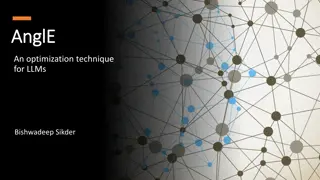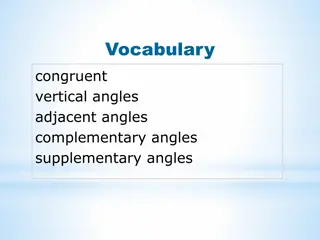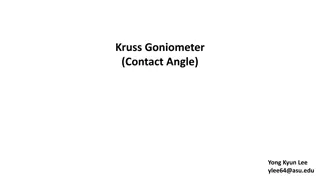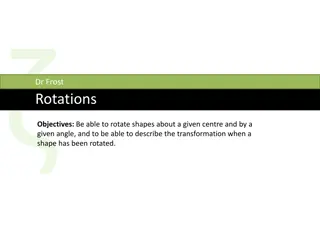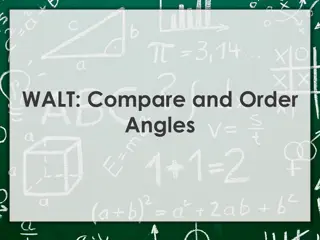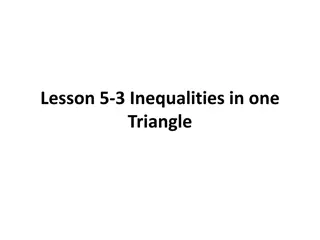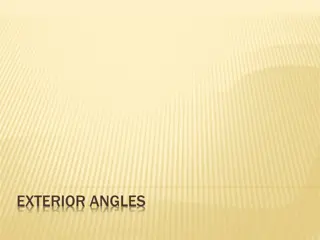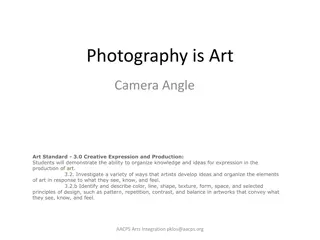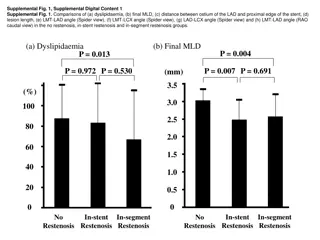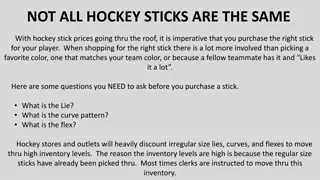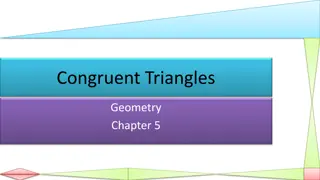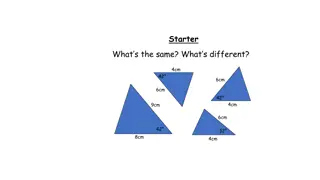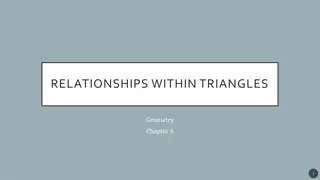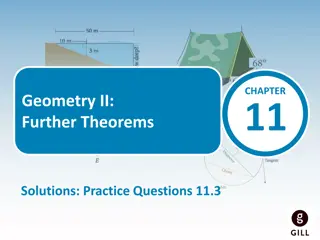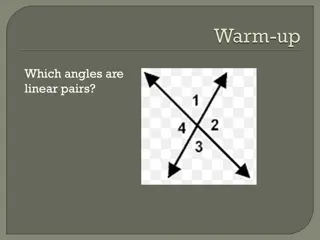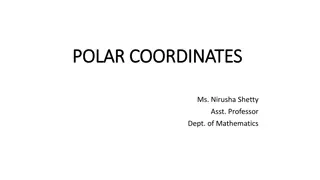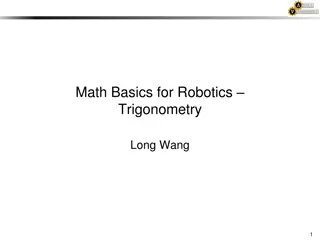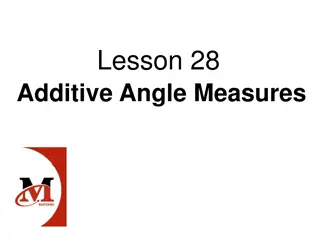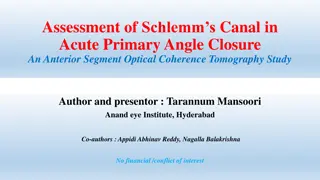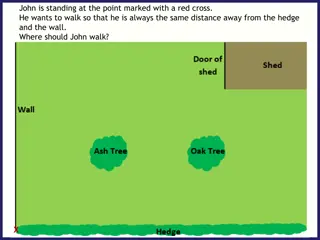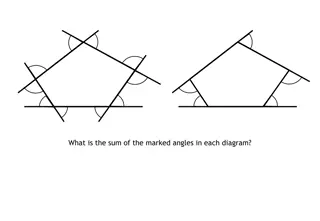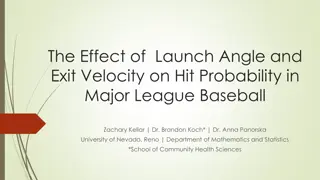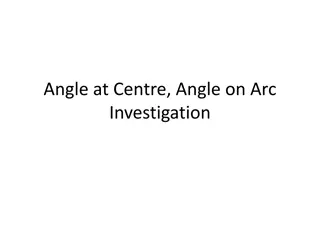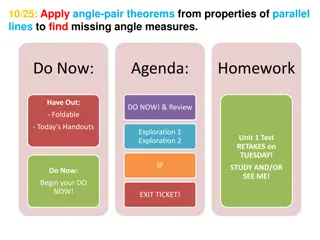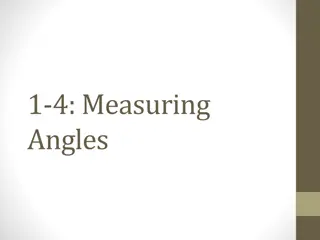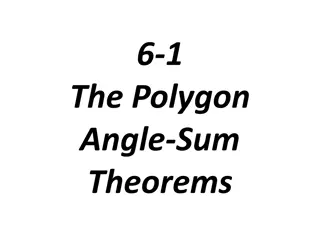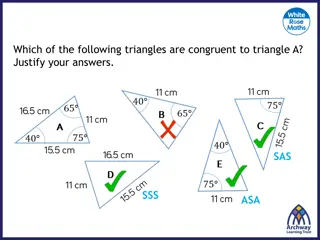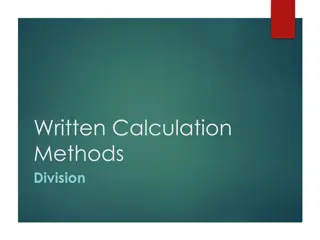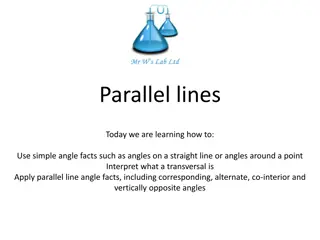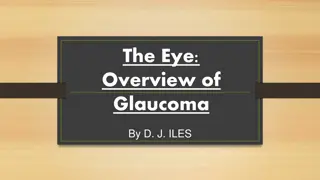AnglE: An Optimization Technique for LLMs by Bishwadeep Sikder
The AnglE model introduces angle optimization to address common challenges like vanishing gradients and underutilization of supervised negatives in Large Language Models (LLMs). By enhancing the gradient and optimization processes, this novel approach improves text embedding learning effectiveness.
9 views • 33 slides
Solving right triangles
Discover how to solve right triangles using trigonometric ratios and angle measures. Explore examples and real-world applications, such as calculating street grades in San Francisco. Learn how to identify angles using sine, cosine, and tangent ratios, and use inverse trigonometric functions to find
0 views • 26 slides
Understanding Prism Terminology and Light Deviation
Prisms are optical devices that deviate light without changing its vergence. This module explores the various terminology associated with prisms, including Apex, Base, Refracting Angle, and Angle of Deviation. The passage of light through a prism follows Snell's Law, where the ray is deviated toward
4 views • 42 slides
Understanding Fresnel Prisms: Advantages, Disadvantages, and Applications
Fresnel prisms, a type of prism where the angle of refraction only depends on the surface angle and material's refractive index, offer advantages such as thinness, lightweight, and flexibility but have disadvantages like cosmetic differences and reduced visual performance. They find applications in
11 views • 24 slides
Understanding Angle Relationships in Geometry
Explore key geometry vocabulary such as congruent, vertical, adjacent, complementary, and supplementary angles. Learn how to identify different types of angle pairs and calculate unknown angle measures using angle relationships. Visual examples and explanations enhance understanding.
1 views • 19 slides
Step-by-Step Guide for Using Kruss Goniometer Contact Angle Analyzer
Detailed instructions on how to operate a Kruss goniometer contact angle analyzer. Learn how to set up the equipment, prepare the sample, adjust camera focus, measure contact angle, and analyze the results. Follow each step carefully to achieve accurate measurements.
1 views • 10 slides
Comparative Analysis of Glaucoma Management Practices in Uganda and the UK
Glaucoma, the 3rd leading cause of blindness in Uganda, is primarily managed by General Ophthalmologists across 20 hospitals in the country. Uganda lacks Glaucoma subspecialists and specialized nurses. Equipment availability varies among hospitals. Cases in Uganda are typically identified through re
0 views • 13 slides
Understanding Rotations in Geometry
Learn how to rotate shapes around a center by a specified angle and describe the resulting transformation. Explore concepts like center of rotation, angle, and sense of rotation. Practice rotations with various examples and understand the process step by step.
2 views • 10 slides
Understanding Facts That Need Not Be Proved Under Evidence Act
The Evidence Act discusses Sections 56-58 covering facts that need not be proved, including judicially noticeable facts, admitted facts, and matters presumed to be true. Judicial notice allows courts to accept common knowledge without formal evidence, while Section 58 deems agreed facts as admitted
1 views • 13 slides
Understanding and Comparing Angles in Mathematics
In this educational material, students will learn to differentiate between acute, right, and obtuse angles. They will practice identifying angles, ordering them from smallest to largest, and determining angles within various shapes. The content also includes reasoning exercises to enhance understand
1 views • 16 slides
Trigonometric Problems: Mixed, Sine and Cosine Rules
This strand delves into trigonometric problems focusing on triangles with mixed information, exploring side lengths and angle measurements beyond right-angled triangles. It covers mixed problems, sine and cosine rules, applying area of any triangle, and Heron's formula. Engage in various exercises i
0 views • 28 slides
Understanding Triangle Inequalities and Angle-Side Relationships
Explore the Vocabulary of Exterior Angle Inequality Theorem, Angle-Side Relationship Theorems 5.9 and 5.10. Understand how to order triangel angle measures and side lengths from smallest to largest through examples. Discover the principles governing triangles in terms of angles and side lengths.
0 views • 12 slides
Understanding Exterior Angles in Polygons
This content explains the concept of exterior angles in polygons and the Exterior Angle Theorem. It covers how exterior angles are formed when the sides of a polygon are extended, their relationship with interior angles, and how to calculate their measures using the Exterior Angle Theorem. Various e
2 views • 26 slides
Enhancing Rowing Performance with Advanced Feedback Systems
Explore the EmPower Oarlock and SpeedCoach GPS systems for rowing, providing real-time feedback on stroke metrics like length, blade engagement, and force. Customize your display with various metrics and receive technical feedback on improving catch angle, finish angle, blade engagement, and more. E
0 views • 11 slides
Exploring Camera Angles in Photography
Photography is a form of art that involves various creative expressions, including the use of different camera angles to capture unique perspectives. This content explores different camera angles such as high-angle shot, low-angle shot, Dutch angle, and straight angle, each offering a distinct visua
1 views • 7 slides
Comparisons of Dyslipidaemia and Lesion Characteristics in Restenosis Groups
This supplemental content presents comparisons of dyslipidaemia, final minimal luminal diameter (MLD), distance between ostium of the LAD and proximal edge of the stent, lesion length, and various angle measurements in different restenosis groups. The findings highlight significant differences in dy
0 views • 4 slides
Threat Analysis and Mitigation Strategies for Impact Event: Briefing Summary
This briefing delves into the potential physical and infrastructure effects of an impact event with an asteroid of up to 400 meters in diameter, traveling at a speed of 16 km/s. The simulation highlights the significant threat of tsunamis resulting from such an impact, with tsunami strength varying
0 views • 5 slides
Choosing the Right Hockey Stick: Understanding Lies, Flex, and Curves
When purchasing a hockey stick, it goes beyond just color or brand name. Understanding factors like lie angle, flex, and curve pattern is crucial for optimal performance. The lie angle determines how much blade is on the ice, impacting handling and shooting. Flex and length also play key roles in fi
0 views • 13 slides
Understanding Triangles: Classifying by Sides and Angles
Delve into the world of triangles in geometry with a focus on classifying them by their sides and angles. Learn about equilateral, scalene, and isosceles triangles based on side lengths, and explore equiangular, right, acute, and obtuse triangles according to angle measurements. Uncover the Triangle
0 views • 60 slides
Understanding Triangle Congruence Properties
Delve into the principles of congruent triangles by exploring the properties of side-side-side (SSS), side-angle-side (SAS), angle-side-angle (ASA), and right-angle-hypotenuse-side (RHS) congruence. Visual explanations help clarify how these properties determine if triangles are congruent.
0 views • 18 slides
Understanding Perpendicular and Angle Bisectors in Geometry
Explore the concepts of perpendicular and angle bisectors in triangles through visuals and theorems. Learn how to identify, utilize, and apply these bisectors to solve problems involving segments and angles within triangles. Enhance your understanding of bisectors with examples and step-by-step expl
0 views • 46 slides
Geometry Practice Questions: Triangles Similarity Theorems
Explore practice questions demonstrating the similarity of triangles based on angle relationships. Understand how to prove similarity using given angle measurements in various triangle configurations. Delve into the concept of similar triangles through visual examples and step-by-step solutions.
0 views • 34 slides
Understanding Angle Relationships with Parallel Lines
Explore the concept of angle relationships created by intersecting lines and transversals. Learn about linear pairs, congruent angles, supplementary angles, alternate interior and exterior angles, corresponding angles, and more. Engage in activities, quizzes, and worksheet assignments to deepen your
0 views • 9 slides
Understanding Polar Coordinates in Mathematics
Polar coordinates define the location of a point in terms of distance and angle from an origin. The distance is denoted by "r" and the angle by "?". However, the angle is not unique for a point. The concept involves fixing an origin and an initial ray, with positive angles measured counterclockwise.
0 views • 7 slides
Understanding Polar Coordinates in Mathematics
Polar coordinates provide an alternative way to plot points using a directed angle and distance from the origin. This system involves radius (distance) and angle measurements, allowing for multiple representations of points. Graphing polar coordinates, converting between polar and rectangular coordi
0 views • 19 slides
Trigonometry Basics for Robotics: Understanding Triangles and Interior Angle Addition
Explore the fundamentals of trigonometry in robotics through an in-depth look at triangles, their components, and the interior angle addition theorem. Learn about vertices, sides, angles, and the centroid of a triangle, as well as special right triangles. Enhance your understanding with detailed exa
0 views • 41 slides
Understanding Additive Angle Measures
In this lesson on additive angle measures, students learn how to find missing angle measures when two non-overlapping angles combine to form a larger angle. Essential questions are posed, and students are guided through solving problems involving angle decomposition and measurement. Practical activi
0 views • 46 slides
Assessment of Schlemm's Canal in Acute Primary Angle Closure: AS-OCT Study
Study conducted by Tarannum Mansoori and team aimed to evaluate Schlemm's canal (SC) dimensions in acute primary angle closure (APAC) using anterior segment optical coherence tomography (AS-OCT). Their findings indicate changes in SC parameters post-treatment, emphasizing the importance of SC in mai
0 views • 6 slides
Exploring concepts of equidistance and angle bisector in geometry
Explore the concepts of equidistance and angle bisectors in geometry through practical examples like determining the path for John to walk equidistant from a hedge and a wall, understanding the ideal flight path for a plane to land, constructing angle bisectors, and verifying constructions for accur
0 views • 23 slides
Geometry Angle Sum and Properties Exploration
Dive into the world of geometry with various diagrams and scenarios focusing on angle sums, concave and convex polygons, and angle measurements. Learn about properties of polygons and test your skills in identifying different shapes and their classifications based on their properties. Explore angles
0 views • 18 slides
The Effect of Launch Angle and Exit Velocity on Hit Probability in Major League Baseball
Research conducted by Zachary Kellar, Dr. Brandon Koch, and Dr. Anna Panorska from the University of Nevada, Reno focuses on the impact of launch angle and exit velocity on the probability of hit success in Major League Baseball. The study aims to maximize successful outcomes by analyzing the statis
0 views • 19 slides
Circle Theorems Investigation
Explore and understand circle theorems by investigating angles on the same arc from a chord, angle at the centre, and how it relates to the angle at the arc. Follow step-by-step visual instructions to compare angles, cut them out, and discover the relationship between angles in circles.
0 views • 16 slides
Understanding Angle Pair Theorems in Geometry
Explore the application of angle-pair theorems in finding missing angle measures using properties of parallel lines. Learn about different types of angle pairs such as vertical angles, corresponding angles, same-side interior angles, alternate exterior angles, and more through engaging activities an
0 views • 14 slides
Understanding Angles: Definitions, Examples, and Postulates
Explore the world of angles with definitions of angle parts, types of angles, angle pairs, Angle Addition Postulate, and more. Dive into examples and classwork exercises to enhance your understanding of angles in geometry.
0 views • 16 slides
Understanding Angle Pair Theorems in Geometry
Learn how to apply angle pair theorems using properties of parallel lines to find missing angle measures. Explore concepts like corresponding angles, alternate interior angles, alternate exterior angles, and consecutive interior angles through visual aids and practice problems.
0 views • 14 slides
Understanding Polygon Angle-Sum Theorems
Explore the Polygon Angle-Sum Theorems that determine the sum of interior angle measures in polygons. Learn about the Polygon Angle-Sum Theorem, number of sides in polygons, finding angle sums, and the corollary for regular polygons. Practice using the theorems to calculate interior angle measures i
0 views • 18 slides
Exploring Triangle Similarity and Congruence
This content delves into understanding triangle congruence and similarity through various scenarios and visual representations. It discusses how to determine congruence using side-side-side, side-angle-side, and angle-side-angle criteria, and explores the concept of similarity in triangles based on
0 views • 21 slides
Year 3 Division Methods and Facts Overview
Explore written calculation methods for division in Year 3, including facts related to times tables such as 2, 3, 4, 5, 8, and 10. Learn about mental division with remainders and progress to dividing numbers up to 4 digits by one- or two-digit numbers using short and long division in Year 4 and 5. D
0 views • 18 slides
Understanding Parallel Lines and Angle Relationships
Learning about parallel lines involves using angle facts like those on a straight line or around a point. By interpreting what a transversal is, you can apply angle relationships such as corresponding, alternate, co-interior, and vertically opposite angles. Practice finding unknown angles and identi
0 views • 20 slides
Understanding Glaucoma: Types, Symptoms, and Treatment Options
Glaucoma is a group of eye conditions that can lead to irreversible vision loss. There are different types such as open-angle, closed-angle, secondary, and normal-tension glaucoma, each with unique characteristics and causes. Symptoms vary from rapid damage in closed-angle glaucoma to gradual periph
0 views • 13 slides
